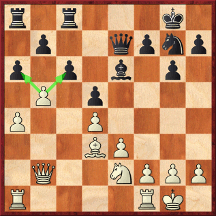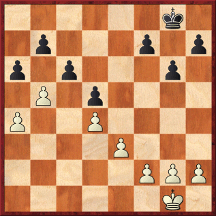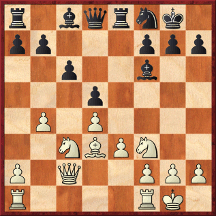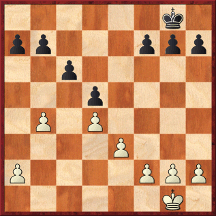We present a column from our archives. First published in October 2009. Members enjoy access to all archived content, including thousands of PDFs and hundreds of Ebooks – all free! To join: make a $25 (or more) tax deductible donation to ChessEdu.org and we will send your log in details for one-year access.
Middlegame Motifs, by Nigel Davies: The Minority Attack
The minority attack is one of the most important middlegame plans. It occurs in asymmetrical pawn structures in which one side has a half-open file. With the use of a pawn lever he then tries to make the file fully open, creating weaknesses in the enemy camp in the process.
The opening in which the minority attack most commonly occurs is the Queen’s Gambit Declined Exchange Variation, which often starts with the moves 1.d4 d5 2.c4 e6 3.Nc3 Nf6 4.cxd5 exd5. In this position both sides have half-open files, White’s being the c-file and Black’s being the e-file.
Both sides will build their game around these assets. After Black plays …c7-c6, to get both his c- and d-pawns protected, White’s minority
attack takes shape. By playing b2-b4-b5 he pries open this file leaving Black with some kind of pawn weakness whatever he does.
The following two games provide a nice introduction to this plan, both of them feature model displays by White. In subsequent articles I hope to look at other aspects of this pawn structure, for now it’s enough that we deal with White’s minority attack plan.
Byrne, Robert (2560) – Eliskases, Erich
Helsinki ol (Men) fin-A (1), 1952
Queen’s Gambit Declined [D36]
1.d4 d5 2.c4 e6 3.Nc3 Nf6 4.cxd5 exd5 5.Bg5 Be7 6.e3 c6 7.Qc2 Nbd7 8.Bd3 Nh5 9.Bxe7 Qxe7 10.Nge2 Nb6 11.0–0 g6 12.Na4!
Black’s knight on b6 was making a minority attack (b2-b4-b5) difficult because of its potential to occupy the c4-square. So White exchanges it off.
12…Nxa4 13.Qxa4 0–0 14.b4

Starting the minority attack. Black’s next move holds it up for a while, but in the long run it’s very difficult for him to stop b4-b5.
Let’s take a look at the pawn structure by itself:

14…a6 15.Qb3
After 15.b5?, Black could play 15…cxb5 16.Bxb5?? Bf5!, which would leave the bishop on b5 without a retreat.
15…Be6 16.a4 Rfc8 17.Qb2 Ng7 18.b5

And now the minority attack breaks through. Whatever Black does he will end up with some pawn weaknesses; for example, capturing on b5 with
his c-pawn leaves the d5-pawn weak. In the game he opts for contracting a weak c6-pawn.
Let’s take another look at the pawn structure:

18…axb5 19.axb5 Bf5
Black should have tried 19…c5 when 20.dxc5 Qxc5 leaves a great square for White’s knight on d4, but this should not be the end of the world.
20.Nf4 Bxd3 21.Nxd3 Nf5 22.Rxa8 Rxa8 23.bxc6 bxc6 24.Rc1 Nh4 25.Qe2
25.Rxc6 Nxg2 26.Kxg2 Qe4+ 27.Kg3 Qxd3 gives Black counterplay.
25…Ra3 26.g3
Here 26.Rxc6 is answered by 26…Qe4 (26…Nxg2) 27.Ne1 Ra1 28.f3 Nxf3+ 29.gxf3 Qh4 30.Kf1 Qh3+ 31.Kg1 Qh4 with a draw by repetition.
26…Qe4 27.Ne1 Nf5 28.Qc2!

The exchange of queens kills Black’s counterplay. Torture time!
28…Qxc2 29.Rxc2 Ne7 30.Kf1 f6
30…h5! would have been a good idea so that White’s g2-g4 would not leave Black with a weak h-pawn.
31.Ke2 Kf7
31…h5! was still the right idea.
32.Nd3 Ke6 33.Rb2 Ra7
33…h5! is still correct, and this was the last chance.
34.g4!
Fixing Black’s h-pawn as a target.
34…g5 35.Rb8 Kf7 36.Rh8 Kg7
36…Kg6 37.h3 Rc7 38.Kd2 Rc8 39.Rxc8 Nxc8 40.Kc3 would see White’s king heading for c5 with the pressure going into the knight endgame.
37.Rd8 Rc7
37…Kg6 38.Rd6 prevents …h7-h5.
38.Nc5 Kf7 39.Kf3 Ng6 40.Kg3 Ra7 41.Rd6 Rc7
41…Ne7 42.Nd7 Ng8 43.Nb8 wins a pawn.
42.Na6 Rc8 43.Rd7+ Ne7 44.Nc5 Ra8 45.Rd6 Ra1

Seeing that White is ready to play h2-h4 and maybe f2-f3 and e3-e4, Black decides that passive defense is doomed to failure.
46.Nd7 f5 47.Ne5+ Kg7 48.h3 fxg4 49.hxg4 Rc1
Or 49…Ra6 50.Re6 Kf8 51.Nf3 leaves Black unable to defend the g5-pawn.
50.Re6 Ng6
50…Kf8 51.Nf3 wins the g5-pawn.
51.Rxc6 Rxc6 52.Nxc6
White is now a pawn up with the d5-pawn being very weak as well. He does a neat job of winning the endgame.
52…Kf6 53.f3 Ke6 54.Nb4 Kd6 55.Kf2 Nf8 56.e4 dxe4 57.fxe4 Ne6 58.e5+ Kd7 59.Ke3 Nf4 60.Nd3 Nd5+ 61.Ke4 Kc6 62.Nf2 Nf4 63.Nd1 h5 64.gxh5 Nxh5 65.Ne3 Nf4 66.Ng4 Ne2 67.Nf6 Ng3+ 68.Kf3 Nf5 69.d5+ Kc5 70.Kg4 Nh6+ 71.Kxg5 Nf7+ 72.Kf4 Kd4 73.e6 Nd6 74.e7 1–0
Reshevsky, Samuel – Myagmarsuren, Lhamsuren
Sousse Interzonal (1), 1967
Queen’s Gambit Declined [D36]
1.d4 e6 2.c4 d5 3.Nc3 Nf6 4.cxd5 exd5 5.Bg5 Be7 6.e3 0–0 7.Bd3 c6 8.Qc2 Nbd7 9.Nf3 Re8 10.0–0 Nf8 11.Bxf6
With this and his next move, White gets his minority attack going straight away. Another way to play for b2-b4 is 11.Rab1!?.
11…Bxf6 12.b4

Again it is important to note the pawn structure:

12…Bg4 13.Nd2 Rc8 14.Bf5 Bxf5 15.Qxf5 g6
In some ways Black would prefer not to do this, because one day he might like to get a rook to g6 or h6. Another possibility was 15…Be7 16.Rab1 a6 17.a4 Bd6, positioning his bishop so that it points at White’s kingside.
16.Qd3 Qd6 17.Rfb1 Bg7 18.a4 Nd7 19.Ra2
White can’t play 19.b5 straightaway because of 19…c5 20.dxc5 Nxc5.
19…Re6 20.Rc2 Rce8 21.Nb3 Nf6
Perhaps Black would have had better chances of counterplay had he played 21…f5!? trying to lever open the e-file. This too is a minority attack, trying to extend control of the half open e-file with a pawn lever.
22.h3 b6 23.Nc1 Bh6 24.N1e2 Nh5 25.b5!

This was a long time in coming, but it’s very strong. White is breaking through on the c-file and the d5-pawn becomes very weak.
25…Qd7 26.bxc6 Rxc6 27.Qb5 Rec8 28.Rbc1 R8c7?!
And here 28…Qe6 would have been better, unpinning the rook and introducing the possibility of a sacrifice on e3.
29.g4 a6
Both 29…Nf6; and 29…Ng7 are answered by 30.Nxd5!.
30.Qxa6 Nf6 31.Nxd5 Nxg4
If 31…Nxd5, there follows 32.Rxc6 Rxc6 33.Qa8+; and 31…Qxd5 is met by 32.Rxc6 Rxc6 33.Qa8+ too.
32.Rxc6 Qxd5? 33.Qa8+! 1–0

After 33…Kg7 34.Rxg6+, Black loses his queen.
Exercises (solutions next month)
Steinitz, William – Lee, Francis
London (11), 13.06.1899

White to play. What is his best move?
Kotov, Alexander – Ragozin, Viacheslav
URS-ch17 Moscow (11), 02.11.1949

White has just played 27.b4-b5. What did he have in mind after
27…c6-c5?
© 2009 Nigel Davies & ChessCafe.com. All Rights Reserved.
Readers’ Responses
Tom from the USA – Two of your new columns, by Nigel Davies on middlegames and Abby Marshall on the opening, are very good, welcome additions to an already excellent site.
Matthias from Germany – Congratulations on the best chess website on the Internet. I think I am not the only one who thinks so.
Bill from Canada – I love the new format and additional features, particularly the news links and Davies’s middlegame column. Thanks for the continuing excellent work.
Miguel from the USA – Wow! Another new column!! The instructional content of this site gets better and better. We now have Abby’s column on openings (not to forget Gary Lane’s and Stefan Bücker’s columns as well, which focus on some more specific and/or offbeat opening ideas), Nigel’s column on the middlegame, which should appeal to us “middling” chessplayers as opposed to Mark Dvoretsky’s higher echelon
discussions and Dan Heisman’s more elementary presentation, and finally Karsten Müller’s endgame column. What a feast!!
Leave a Reply